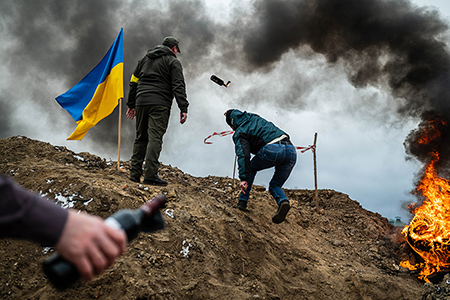
Continuing through November 18, 2023
From its very beginnings, the photographic medium has possessed a special ability to capture “the human condition” with power and clarity. Perhaps it is how directly the photographic gaze mimics our own compared with other visual mediums. It provides a perception we accept as “real.” In this regard, photography found its way early on to the intensive documentation of conflict. It continues to cast a powerful eye on the realities of war.
“Fighting: Ukrainian War Photographers” confronts the breadth of conflict once again. Co-curated in Prague by Jan Pohribný and Igor Malijevský, with support from the Ukrainian Association of Professional Photographers (UAPP), the show features 255 images by 16 artists and photojournalists. This extensive display documents the Russian military’s full-scale invasion of Ukraine, which began in February 2022 and continues to this day. The Russian dictator expected that the conflict would last a few weeks, but it has continued due to the resistance and resilience of the Ukrainian people as well as the support of the U.S., NATO, and other allies.
The curators edited the show from more than 20,000 images taken by the photographers Mstyslav Chernov, Pavlo Dorohoy, Andriy Dubchak, Yurko Dyachyshyn, Alexey Furman, Alena Grom, Serhii Korovayny, Olga Kovalova, Kostiantyn and Vlada Liberov, Evgeny Maloletka, Sergi Mykhalchuk, Mikhail Palinchak, Danilo Pavlov, Viacheslav Ratynskyi, and Alina Smutko.
The images are grouped into five sections: The Struggle, Mariupol, Flight, Life and Loss during War, and Hope. They document the destruction and loss of life, the refugee crisis, and the continuing display by the Ukrainian people of strength and hope. The eyes of the subjects tell the story. Whether it is a portrait of a child in a train station or the gaze of an armed soldier in the field, their eyes reveal fear, resolve, pain, and confusion.
Without exception, the photographs are technically adroit, reflecting the skill of the photographers and the aesthetic possibilities their digital tools provide. At the same time, these images go beyond merely documenting the situation, conveying powerfully the full range of emotions of both combatants and civilians.
In an international online panel discussion, the curators and UAPP members Kovalova, Dorohoy, Dubchak, Grom, and Ratynskyi discussed their experiences taking these photographs. “We are writing the Ukrainian history with our cameras,” said Kovalova. According to Ratynskyi, “Because of the occupation, there is no access for international journalists. If not for us, the world may never know about the horror that people are going through.”
Grom did a project about children surviving in their small town, which has been destroyed completely. “I have no idea what happened to those kids,” she said. “I went to a railway station where millions of displaced Ukrainians were arriving. I started doing recordings of the stories of survivors.” Grom’s portrait “Nikita” portrays a traumatized child clutching a stuffed toy as he waits to escape the turmoil of the war in Krivoy Rog, a city of more than half a million people. The dark circles around his eyes reveal his fear and stress at leaving his father behind to fight.
Ratynskyi took a photograph of people practicing throwing Molotov cocktails in Zhytomyr. “I took this picture in my hometown in the first couple of days of the invasion,” he said. “People were preparing to resist, not flee the town. I was surprised by the heroism and bravery of my people because they were not going to run away but were preparing themselves to protect their hometown at any cost.” He pointed out that the war actually started 10 years ago, but no one was really talking about it until the full-scale invasion. “Without this attention, Ukraine would not make it,” he said. “It is about future political developments that could change the world. Please be prepared.”
In the midst of war and devastation, Palinchak encountered brief interludes of normalcy and happiness. In “Wedding,” two soldiers dressed in camouflage attire have paused to marry. The bride wears a flowered tiara and holds a bouquet. In another poignant image titled “The words No War,” Dorohoy captures the resilient faith of Ukrainians that peace will prevail.
To bring this message to a larger audience, these photographers have braved the dangers of the front lines to document the devastation and explore the emotions and unshakable will of their countrymen and women. The section on Hope, in particular, reveals the extraordinary ability of people to find moments of joy and community amid dire circumstances.
